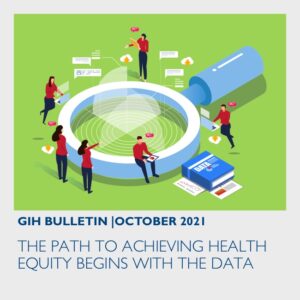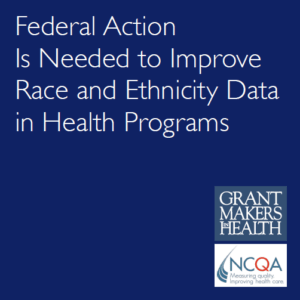Cara V. James, PhD, President and CEO, Grantmakers In Health
Whether you are working to address climate change, the COVID-19 pandemic, maternal health, rural health, mental health, or any other health issue, it all begins with the data. As Lord Kelvin said, “If you cannot measure it, you cannot improve it.” An anecdote can be an indicator of a problem, but you need quantitative data to know whether you truly have a problem, how large the problem is, and whether you are making progress addressing it.
The path to achieving health equity begins with the ability to identify and understand the drivers of health disparities. For decades, researchers, advocates, and policymakers have noted the need for better data to measure health disparities. National statistics often do not include small populations—such as American Indians and Alaska Natives or Native Hawaiian and Other Pacific Islanders—and it is not uncommon to see data by race reported only for White, Black, Hispanic, and Other. Some researchers and others argue that it would take up too much space to report disaggregated data for all racial and ethnic populations, or that we should only report data for a given population group if we can do so for all indicators. This approach causes us to miss problems and contributes to structural biases by focusing us only on what we can or choose to see. For example, it was not until 2017 that the Centers for Disease Control and Prevention (CDC) began reporting infant mortality rates for Native Hawaiian and Other Pacific Islander mothers separate from Asian mothers, despite a federal data standard established in 1997 that requires two categories when asking the question (CDC 2019). Disaggregating the two populations revealed an alarming statistic. In 2017, the infant mortality rate for Native Hawaiian and Other Pacific Islander women was twice that of Asian mothers, and in 2018, the rate was more than 2.5 times that of Asian mothers, making it the second highest rate for all mothers after Black mothers.
Another challenge with health equity data is the high percentage of missing data in our administrative data sets. Several months into the COVID-19 pandemic, we did not know whether communities of color who were disproportionately impacted by the pandemic were getting tested, and more than 10 months after the first COVID-19 vaccine was administered in the United States, the CDC is missing race and ethnicity data for nearly 40 percent of the doses administered (CDC 2021). This missing data issue is not unique to the pandemic. According to the Centers for Medicare & Medicaid Services, the Medicaid race and ethnicity data in 22 states is highly concerning or unusable as measured by multiple factors (Medicaid.gov 2021).
There are myriad reasons for missing data, including misperceptions about the legality of asking someone to provide the information; not asking because of discomfort associated with asking; and a lack of willingness by the individual to share personal information. It is worth noting that health surveys such as the Behavioral Risk Factor Surveillance System (BRFSS) and the National Health Interview Survey (NHIS) have significantly lower rates of missing data, suggesting that people are willing to share information about their race and ethnicity when asked to do so (CDC 2019, 2021).
Over the last year and a half we have seen significant increases in interest, resources, and initiatives focused on health and racial equity. Numerous organizations have created health equity positions and implemented diversity, equity, and inclusion strategies. However, fewer resources and initiatives have focused on improving the data necessary to support our equity journey. As we work towards a more just and equitable future, we must ensure that we have the data needed to measure the things we are trying to improve. It is no longer acceptable to say we do not know.
Closing data gaps requires action across all sectors. Two recently released reports, supported by health funders, provide recommendations to help improve the data needed to track our progress towards health equity. Federal Action Is Needed to Improve Race and Ethnicity Data in Health Programs, a report that GIH developed in collaboration with the National Committee on Quality Assurance (NCQA), assesses the current state of race and ethnicity data at the federal and state level, and provides concrete steps that the federal government can take immediately to address long-standing data issues. The report includes 11 recommendations that are divided into four areas: 1) changes in data standards and systems, 2) incentives and requirements, 3) education and technical assistance, and 4) regulation. A second report, Charting A Course for an Equity-Centered Data System, released by the Robert Wood Johnson Foundation, provides recommendations to support the transformation of our public health data systems.
To close data gaps, we need more health funders to support the collection, analysis, and reporting of health equity data at the federal, state, and local levels. In addition to data on race and ethnicity, we need support for more and better data on language preference, disability, and other social determinants of health. Health funders can also help advocate for policies that make it easier to share data within and between health, social, and human service programs, as well as across other sectors—such as education—to improve coordination and continuity of services. Finally, philanthropy can continue to support research, analysis, and the dissemination of findings to foster continued dialogue and sharing of resources.
As we continue efforts to advance health equity, we need to keep the data in the forefront and focus on removing barriers, providing guidance and resources to help improve our data infrastructure and data integrity, and supporting interoperability and data use. Working together, we can improve our data systems to measure what matters and use those data to drive the changes needed to achieve health equity.
References
CDC. Infant, neonatal, postneonatal, fetal, and perinatal mortality rates, by detailed race and Hispanic origin of mother: United States, selected years 1983–2018.
CDC. Demographic Characteristics of People Receiving COVID-19 Vaccinations in the United States.
CDC. LLCP 2020 Codebook Report.
CDC. 2019 NATIONAL HEALTH INTERVIEW SURVEY.
Medicaid.gov. DQ Assessments.


